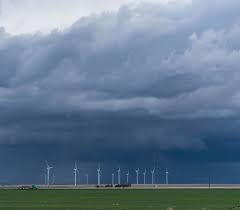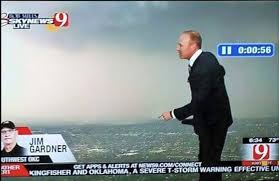
It’s a problem that even KWTV chief meteorologist David Payne has experienced—radar interference caused by wind farms in Oklahoma.
It’s especially critical when Payne and his experienced team of storm trackers are chasing and monitoring what can be dangerous and even deadly thunderstorms and tornadoes. When storm move over areas with wind turbines, it results in false readings on radar.
“The data starts to look really, really fuzzy,” explained Payne in an investigation by News 9 Investigative reporter Alex Cameron.
Payne says, it’s a simple fact that wind turbines contaminate radar data.
Looking at a live radar image in the station’s weather center, Payne pointed to a cluster of green and yellow dots in northwest Oklahoma: “That’s not rain,” the meteorologist stated, “it’s clear up there.”
When the skies are clear and there’s no inclement weather, Payne says the wind farms don’t pose a problem, because he and his colleagues know the returns they see are just the radar reflecting off the turbines. He says the problem is when there is weather, and it’s moving over a wind farm.

“There are times when I’m looking at wind velocity data, at damaging winds or at an area of circulation,” Payne related, “and I’ve gone, ‘Hang on a second– what’s real and what’s not?’ Ya know, what’s a wind turbine versus what’s real data?”
It has not been overlooked by national weather experts.
Similar questions arise at the National Weather Service in Norman, where Jessica Schultz is the radar program manager. She showed us another example of wind turbines interfering with radar data.
“So here you have a thunderstorm developing, or shower developing,” Schultz pointed to a screen in her office, “and here’s the wind project just west of Garber.”
As the shower moves to the northeast, the small storm gets lost in the wind farm.
Schultz says, as new wind projects are developed across the country, it’s her job to analyze them for the potential to interfere with nearby radar.
“Our concern is those close call situations where you have a thunderstorm that’s rapidly evolving, moving across the wind turbine area,” Schultz explained, “when it can make it more difficult to discern what exactly is happening.”
Since 2006, the National Weather Service has analyzed about 1,700 wind projects across the country. But Schultz says they don’t have the legal authority to stop any of the projects from moving forward; they pass along any concerns they might have to the local communities and the project developers, and hope they listen.
Officials with the wind industry say they do listen.
“They take it very seriously,” said Mark Yates, Oklahoma Director for the Wind Coalition, an industry trade association.
Yates says developers are aware of the issue and understand that the interference gets worse the closer the turbines are to the radar.
“The industry is more than willing to cooperate with the National Weather Service and NOAA,” Yates said, “to make sure that these situations are mitigated, because safety is the number one concern.”
Click here to view Alex Cameron’s report.





